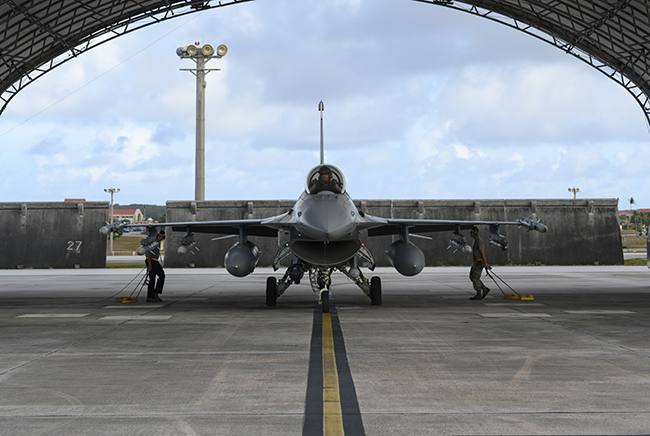
USAF crew chiefs assigned to the 35th Fighter Wing put chocks down to secure a USAF F-16 Fighting Falcon at Andersen AFB, Guam, April 22, 2019. Air Force photo by SSgt. Brittany A. Chase.
Pacific Air Forces on Monday conducted a large-scale exercise, in which aircraft from several units scattered to multiple operating locations to ensure they could continue operating if forced to abandon a base.
Resilient Typhoon simulated an event such as inclement weather that could render a major base inoperable. Aircraft from across Pacific Air Forces deployed to Andersen AFB, Guam, and then quickly dispersed to locations in Guam, Tinian, Saipan, the Federated States of Micronesia, and Palau.
“Operational environments and global threats evolve rapidly,” Brig. Gen. Michael Winkler, the PACAF director of strategy, plans, and programs, said in a release. “We must ensure that all forward-deployed forces are ready for a potential contingency with little notice and that we can move more fluidly across the theater to seize, retain, and exploit the initiative in any environment.”
This exercise included F-16s from the 35th Fighter Wing at Misawa AB, Japan; F-15Cs from Kadena AB, Japan; C-130Js from Yokota AB, Japan; C-17s and F-22s from JB Pearl Harbor-Hickam, Hawaii; and additional capability from Andersen and JB Elmendorf-Richard, Alaska.
PACAF Commander Gen. Charles Q. Brown told Air Force Magazine earlier this year that his command is surveying sites in the region and meeting with governments to determine which airfields and capabilities would be available to the Air Force if needed in a contingency.
“One of the key parts for us is our ability to move into locations and support in a crisis for humanitarian assistance and response,” Brown said, adding that, “The better we understand some of these airfields, and fuel capacities” the “faster” and “more responsive” US aircraft can be.